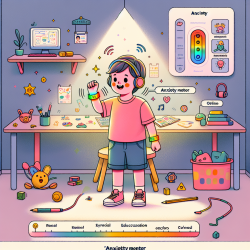Introduction: A New Approach to Anxiety Management
Anxiety is a common challenge for children with Autism Spectrum Disorder (ASD), often complicating their social interactions and daily activities. Traditional interventions like cognitive-behavioral therapy (CBT) have shown promise, but they require a level of self-awareness that many children with ASD find difficult to achieve. Enter the Anxiety Meter—a wearable technology designed to detect anxiety in real-time and provide feedback to the user. A recent pilot study explored the potential of this device to enhance anxiety awareness and management in children with ASD.
The Study: A Closer Look
The study, conducted by Nguyen et al., involved 28 children with ASD who were trained to use the Anxiety Meter. This device uses sensors to monitor heart rate and other physiological signals, translating them into a visual display of anxiety levels. Over four visits, participants were taught to use the device and practice diaphragmatic breathing—a relaxation technique.
During the final visit, participants were divided into two groups: one received real-time feedback from the Anxiety Meter during a stress-inducing task (public speaking), while the other did not. The results were promising: those who received feedback were more likely to initiate deep breathing, suggesting that the Anxiety Meter can effectively enhance self-awareness and anxiety management.
Implications for Practitioners
For practitioners working with children with ASD, the Anxiety Meter offers a novel tool to support anxiety management. Here’s how you can incorporate these findings into your practice:
- Introduce Wearable Tech: Consider integrating wearable technology like the Anxiety Meter into your therapy sessions. This can provide real-time feedback and help children become more aware of their anxiety levels.
- Focus on Self-Awareness: Use the device as a tool to teach children about their physiological responses to stress. This can enhance their understanding of anxiety and improve their ability to manage it.
- Combine with Relaxation Techniques: Pair the use of the Anxiety Meter with relaxation techniques like diaphragmatic breathing. This combination can empower children to take proactive steps in managing their anxiety.
Encouraging Further Research
While the study’s findings are promising, they are based on a small sample size and controlled settings. Practitioners are encouraged to explore further research and consider conducting their own studies to evaluate the effectiveness of wearable technology in different settings and populations. By contributing to the body of research, you can help refine these tools and enhance their applicability in real-world scenarios.
Conclusion: A Step Forward in Anxiety Management
The Anxiety Meter represents a significant advancement in the management of anxiety for children with ASD. By providing real-time feedback and supporting self-awareness, this technology has the potential to transform therapeutic approaches and improve outcomes for children struggling with anxiety. As a practitioner, embracing such innovations can enhance your practice and offer new hope to the children and families you support.
To read the original research paper, please follow this link: Examining the effect of a wearable, anxiety detection technology on improving the awareness of anxiety signs in autism spectrum disorder: a pilot randomized controlled trial.










